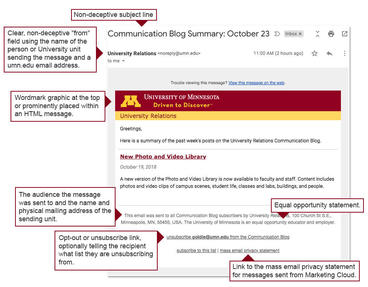University requirements, coupled with federal legislation, must be followed when sending messages within or outside the University.
- Send the message as commercial or transactional.
- Include all required content for the type of message you’re sending.
- Follow CAN-SPAM legislation.
- Use University branding.
- Comply with DMARC
Commercial and Transactional Messages
When you send a mass email, you have a choice between making your message transactional or commercial.
Almost all messages we send at the U are considered commercial.
What is a commercial email?
Messages are considered commercial when they advertise, promote, or inform recipients of a product, service, or initiative.
Messages are considered commercial when they do not qualify as transactional.
What is a transactional email?
Messages sent by University units are considered transactional when they meet at least one of the following conditions:
- Messages sent as official communications (e.g., legally required training or notifications, Timely Warnings from UMPD, class cancellations, building closure).
- Messages sent to confirm a transaction (e.g., Here is your receipt, Thanks for signing up, Your account has been created).
- Messages sent as an update to a transaction (e.g., The event you registered for has been relocated).
- Messages sent as an event confirmation to notify attendees of parking, venue info, etc.
- Non-marketing messages sent to a list created for a class, members of a student organization, or residents of a residence hall.
- Non-marketing messages sent to any combination of students, faculty, or staff members within their own college, department, or unit.
- Messages where your only recipients are listservs or Google groups. The unsubscribes will be handled by the delivering system.
Required Message Content
Commercial and transactional email messages must include all of the following to be in compliance with federal CAN-SPAM regulations and University branding:
- Clear, non-deceptive "from" field using the name of the person or University unit sending the message and a umn.edu email address.
- Non-deceptive subject line.
- Wordmark graphic at the top or prominently placed within an HTML message.
- “University of Minnesota” clearly identified in plain text messages and in the text-only portion that accompanies an HTML message.
In the message footer:
- The audience the message was sent to and the name and physical mailing address of the sending unit (e.g., "This message was sent to weekly newsletter subscribers by the Office of the President at the University of Minnesota, 202 Morrill Hall, 100 Church Street, Minneapolis, MN 55455.").
- For commercial only—Opt-out or unsubscribe link
- If possible, state specifically what messages they will unsubscribe from (e.g., “unsubscribe from the Communication Blog”).
- Transactional messages should never have an unsubscribe link and should not use SMC Publication Lists.
- A link to the University's mass email privacy statement .

CAN-SPAM
University units sending commercial messages must be aware of and adhere to the federal CAN-SPAM Act.
- Don’t use false or misleading header information.
- Don’t use deceptive subject lines.
- Tell recipients where you’re located.
- Tell recipients how to opt out of receiving future email from you.
- Honor opt-out requests promptly.
- If you hire a third party email vendor, monitor what they are doing on your behalf.
Branding in Mass Email
Many of the same branding rules used for web and print also apply to mass email.
U of M mass email must:
- Include the University Wordmark at the top of a message
- Use the Block M or Wordmark only once in the message
- Use a Wordmark that is a minimum of 180 pixels wide
The mass email templates include a Block M and Wordmark combination that has been optimized for email.
Branded templates for Marketing Cloud can be found in “Content > SHARED > Shared Content”.
Branded templates can also be downloaded from the Mass Email Templates page.
Domain-based Message Authentication (DMARC)
The University of Minnesota uses an authentication system—DMARC—to identify legitimate umn.edu messaging and detect unauthorized activity such as phishing and spam.
Units that send mass email from a umn.edu address through the approved list of enterprise systems below have DMARC enabled and do not need to do anything to make sure their messages are being received.
Units using systems that are not supported by central OIT need to take steps to add DMARC authentication to the system(s) they’re using.
List of approved systems:
- Salesforce (was ExactTarget)
- UMN SMTP Mail Relay (Smtp.umn.edu)
- Drupal sites (not using a custom module)
- Google Groups / Gmail / Google SMTP (smtp.gmail.com)
- Hubspot
- Amazon Web Services (AWS)
- Technolutions (Slate)
- AudienceView
- Mailchimp (when configured properly)
For more information about DMARC and the steps you need to take if you need to set up DMARC, see the Email Security: Domain-based Message Authentication (DMARC) page on the IT website.
Related Resources
Guidelines
- External Mass Email Definition and Lists
- Internal Mass Email Definition, Usage Guidelines, and Best Practices
- Internal Mass Email Lists